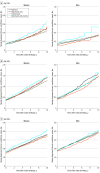Association of Depression and Anxiety With the Accumulation of Chronic Conditions
- PMID: 35499825
- PMCID: PMC9062691
- DOI: 10.1001/jamanetworkopen.2022.9817
Association of Depression and Anxiety With the Accumulation of Chronic Conditions
Abstract
Importance: Longitudinal associations between comorbid depression and anxiety with the accumulation of chronic illnesses are unclear, and questions remain about the contributions associated with each condition in the increasing prevalence of multimorbidity.
Objective: To compare the risk and rate of accumulating chronic conditions in people with depression, anxiety, and comorbid depression and anxiety vs individuals with neither depression nor anxiety.
Design, setting, and participants: This cohort study used the Rochester Epidemiology Project medical records-linkage system to identify residents of Olmsted County, Minnesota, from January 1, 2005, to December 31, 2014, with follow-up ending December 31, 2017. The sample was divided into cohorts anchored at birthday ages of 20, 40, and 60 years. Individuals were classified at anchoring birthday age as having depression alone, anxiety alone, comorbid depression and anxiety, or neither depression nor anxiety (reference group), using electronically extracted diagnosis codes from the International Classification of Diseases, Ninth Revision (ICD-9) in the 5 years before each anchoring birthday. Data were analyzed from August 2020 through November 2021.
Exposures: Depression alone, anxiety alone, comorbid depression and anxiety, or neither depression nor anxiety (reference group).
Main outcomes and measures: The main outcome was sex-specific risk, calculated as hazard ratios (HRs) and rates of accumulation, calculated as mean annual incidence rates per 100 person-years, of 15 common chronic conditions within each birthday age cohort through the end of study.
Results: Among the 40 360 individuals included across all 3 age cohorts, 21 516 (53.3%) were women. After balancing cohorts on race, Hispanic ethnicity, education level, body mass index, smoking status, and calendar year at index birthday, the risk of accumulating chronic conditions was significantly increased among women with depression alone (cohort aged 20 years: HR, 1.20 [95% CI, 1.02-1.42]; cohort aged 40 years: HR, 1.20 [95% CI, 1.10-1.31]; cohort aged 60 years: HR, 1.09 [95% CI, 1.02-1.16]) and women with comorbid depression and anxiety (cohort aged 20 years: HR, 1.60 [95% CI, 1.28-1.99]; cohort aged 40 years: HR, 1.41 [95% CI, 1.21-1.65]; cohort aged 60 years: HR, 1.29 [95% CI, 1.15-1.44]) compared with referent women in the same birthday cohorts and in men with comorbid depression and anxiety compared with referent men in the cohort aged 20 years (HR, 1.77 [95% CI, 1.08-2.91]). For women, the rates of accumulation of conditions were significantly higher across birthday cohorts in the comorbid depression and anxiety group compared with the depression alone group (eg, cohort aged 20 years: difference, 1.2 [95% CI, 0.2-2.1] per 100 person-years) and reference group (eg, cohort aged 20 years: difference, 1.7 [95% CI, 0.9-2.6] per 100 person-years). For men, compared with the reference group, the rates of accumulation of conditions were significantly higher in men with comorbid depression and anxiety in the cohort aged 20 years (difference, 1.4 [95% CI, 0.1-2.6] per 100 person-years) and in men with depression in the cohort aged 40 years (difference, 2.0 [95% CI, 0.8-3.2] per 100 person-years).
Conclusions and relevance: In this cohort study, the risk of accumulating chronic conditions was increased with depression and comorbid depression and anxiety in women across the age span and in younger men with comorbid depression and anxiety. Compared with women without depression or anxiety, there was a more rapid rate of accumulation of chronic conditions in women with depression and anxiety individually and an even higher rate when depression and anxiety cooccurred.
Conflict of interest statement
Figures



